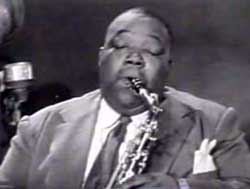 The Official Films one-reel compilation of three soundies, distributed for home projector use as Jazz & Jive (1947), included Fats Waller's Your Feets Too Big (1941), the Delta Rhythm Boys singing Take the "A" Train (1941), & Count Basie & His Orchestra in Take Me Back, Baby (1941) with saxophonist Jimmy Rushing singing the vocal.
The Official Films one-reel compilation of three soundies, distributed for home projector use as Jazz & Jive (1947), included Fats Waller's Your Feets Too Big (1941), the Delta Rhythm Boys singing Take the "A" Train (1941), & Count Basie & His Orchestra in Take Me Back, Baby (1941) with saxophonist Jimmy Rushing singing the vocal.
There are some splendid close-up portraits of individual band members, with the damnedest expressions on several of the guys, but especially on Jimmy's round face. He's daydreaming rather than playing his sax, & he goes into a dream where he's calling up with bluesy musicality to his girlfriend's window:
"Take me back baby, you're all I'm craving for/ Take me back baby, please let me have once more/ The keys on my keyring that opens your front door."
I especially like the line, "Take me back baby, I'm kind of plump that's true,' as Jimmy's a big guy. Being good lookin' & talented makes up for the extra weight, though, & the beautiful gal takes him back, in this memory or fantasy at least.
He lets his gal rip away his little black book since he won't need them anymore. When she checks out who he's been dating, the last girl on the list is Min Oco, noted as "real gal." Minoco was the company that made the soundie. Then all of a sudden, Basie is shaking Jimmy awake as he's totally nodded off in the orchestra.
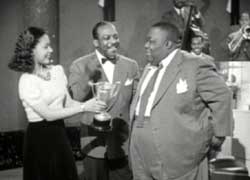 "Now here's a boogie woogie, solid beat/ Come you dancers, on your feet."
"Now here's a boogie woogie, solid beat/ Come you dancers, on your feet."
I dunno why, but hearing Count Basie rap a lyric is quite a thrill just cuz he never does it. But he introduces Air Mail Special (1941) as a boogie woogie contest for the dancers, then the number's on its way.
Although the beat is indeed correct to boogie woogie to, it's by no means the same-old boogie woogie progression heard time & again, as Count Basie is simply always an original.
The dance contestants are actually Whitey's Lindy Hoppers, from the Savoy Ballroom in Harlem, who can also be seen in the Marx Brothers film A Day at the Races (1937), & the black-cast musical review Helzapoppin (1941), plus a few other films & a small handful of soundies including Duke Ellington's Hot Chocolate (1941).
In Air Mail Special we see among Whitey's Lindo Hoppers rotund bluesman Jimmy Rushing cutting the rug with the dancers.
It's played out as a comedy as the Lindy Hoppers dance so ferocioiusly that they drop to the floor in exhaustion one, but Rushing like the turtle versus the hare just keeps trundling along until he & his gal are the last couple standing, winning the dance trophy.
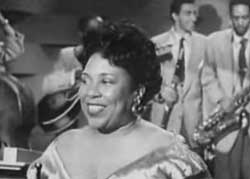 One of the finer Snader telescriptions is Count Basie & his quintet in I Cried for You (1950), on the same set as other Snaders like One O'Clock Jump (1950).
One of the finer Snader telescriptions is Count Basie & his quintet in I Cried for You (1950), on the same set as other Snaders like One O'Clock Jump (1950).
I Cried for You leads off with a sweet soft sax solo by Wardell Gray, his face serene as he performs.
Into this gorgeous soft-jazz instrumental Helen Hulmes appears to add an amazing vocal:
"I cried for you, now it's your turn to cry over me/ But every road has a turnin'/ And that's just one thing you're learnin'/ Yes I cried for you, what I fool I used to be..."
Helen Hulmes is an earlier Ella or Aretha who really belts out a great piece of jump-blues. She had performed with Basie off & on since the late 1930s.
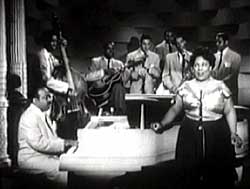 Helen again joins the Count Basie Combo to perform in the Studio Telescription If I Could Be With You (1952).
Helen again joins the Count Basie Combo to perform in the Studio Telescription If I Could Be With You (1952).
She starts off with a blues introduction, Basie hitting the fewest possible notes at the piano behind her voice:
"I'm so blue, I don't know what to do/ All day long I sit & dream of you/ I don't know why I let you go away/ When I dream about you night & day/ I'm unhappy & I'm so dissatisfied/ but I'd be happy if I had you back by my side."
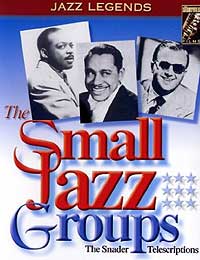 It goes into a slow swing number thereafter, the combo staying sweet & low behind her: It goes into a slow swing number thereafter, the combo staying sweet & low behind her:
"If I could be with you going out tonight/ And I was free to do the things I might/ I want you to know, I wouldn't go/ Until I told you that I loved you so."
Hume has a youthful high sexy voice, but she's no glamor girl, she's a large middleaged woman. Nevertheless, singing transforms her into a beauty, a chubby-chaser's dream sweetheart.
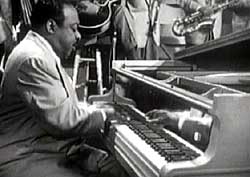 William Count Basie with his combo perform on the Snader telescription Basie Boogie (1950). This one has especially good close-up portraits of each band member during this live performance.
William Count Basie with his combo perform on the Snader telescription Basie Boogie (1950). This one has especially good close-up portraits of each band member during this live performance.
Basie is most on-screen, smiling, pounding the keys in a close approximation of stride though he's too controlled & elegant a player to really go striding.
A sax solo follows by Wardell Gray, then clarinet solo by Buddy de Franco (the quintet's one white player), a slap base solo by Jimmy Lewis & back to the Count. Plus Freddie Green is on guitar without a solo, & that's Joe Jones, not Gus Johnson, on drums.
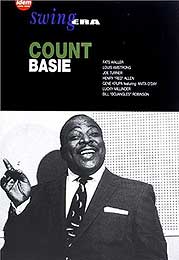 These guys do pretty much the same "round" of solos but with Basie's piano having the largest share of the show in Count 'Em (1950) again flowing from sax solo to clarinet solo then a highlight for the slap base & back to the Count on piano. There's no clarinet solo this time. This is the closest Basie comes to straight-out boogie-woogie b These guys do pretty much the same "round" of solos but with Basie's piano having the largest share of the show in Count 'Em (1950) again flowing from sax solo to clarinet solo then a highlight for the slap base & back to the Count on piano. There's no clarinet solo this time. This is the closest Basie comes to straight-out boogie-woogie b
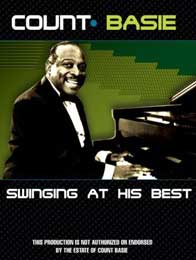 Two more telescriptions featuring Count Basie, Basie's Conversation (1951) & One O'Clock Jump (1950) were incorporated into Rhythm & Blues Review (1955). Two more telescriptions featuring Count Basie, Basie's Conversation (1951) & One O'Clock Jump (1950) were incorporated into Rhythm & Blues Review (1955).
Basie's telescriptions & soundies, with other material, can be found on various video compilations, including Count Basie Swinging at His Best (2005), adding some clips from other sources such as "It's Now Baby or Never" with Billie Holiday the vocalist, from the short musical film 'Sugar Chile' Robinson, Billie Holliday, Count Basie & His Sextet (1951).
Some of the soundies & telescriptions are also to be found on the compilation Swing Era: Count Basie (2004). The latter though titled for the Basie material is inclusive of soundies by several other artists: Fats Waller, Louis Armstrong, Lucky Millinder, Big Joe Turner, Red Allen, Bill Bojangles Robinson, & Gene Krupa.
The Basie telescriptions but no soundies are also included along with ones by Cab Calloway & George Shearing on The Small Jazz Groups: The Snader Telescription 1950-1952 (1999). There are additional compilations as well. None are ever remastered & restored that I've seen, so quality will vary greatly from piece to piece, with some forgiveness required.
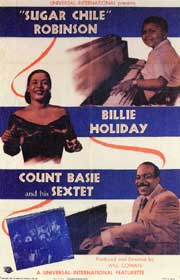 'Sugar Chile' Robinson, Billie Holiday, Count Basie & His Sextet is an amazing quarter-hour film. William Count Basie is the host of the program. As I write this, it is a nominee for the National Film Registry, & would sure belong thereon. 'Sugar Chile' Robinson, Billie Holiday, Count Basie & His Sextet is an amazing quarter-hour film. William Count Basie is the host of the program. As I write this, it is a nominee for the National Film Registry, & would sure belong thereon.
Because of racism in Hollywood did not like to show whites & blacks getting along happily together, Basie's white clarinetest Buddy De Franco, though heard on the soundtrack, is replaced on-screen by Marshall Royal. It's otherwise the Sextet he was touring with, along with Billie & Sugar Chile, & this film captures the general tone of what he was up to in 1950.
Billie Holliday & Count Basie first performed together in 1937, & would reconnect throughout her career for some of the best of her great performances. Here he introduces Billie as his favorite vocalist & as "America's number one song stylist."
In evening gown she strolls to the front of the sextet in the club setting, & begins "God Bless the Child," composed by herself & Arthur Herzog, Jr. What an amazing voice for this classic blues number:
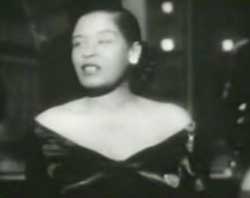 "Them that's got shall have; them that's not shall lose/ So the Bible says, & it still is news/ Mama may have. Papa may have/ But God bless the child that's got his own. That's got his own...." "Them that's got shall have; them that's not shall lose/ So the Bible says, & it still is news/ Mama may have. Papa may have/ But God bless the child that's got his own. That's got his own...."
Here we have together in a single soul one the greatest songs with one of the greatest singers humanity ever produced.
Billie said the seed of this song grew out of an argument she had with her mother over money. It's been sung since by everyone from Ella Fitzgerald to Lisa Simpson, but the original continues to stand as the best.
She also sings "Now or Never" which she co-wrote with Curtis R. Lewis. Though nowhere near the equal of her great signature song, it's a good piece. The lyrics change slightly between this performance & versions for 78 rpm play.
"Hey there baby make up your mind/ Cuz I've been waiting such a long long time/ Now baby or never been so sad & blue/ Now baby or never, I been so lonesome too/ Now baby or never if I mean anything to you..."
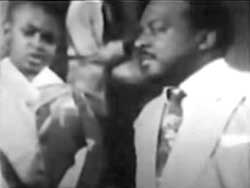 Extraordinary as Billie is, it's surprising to note that this film's immediate attention-getter is Frank 'Sugar Chile' Robinson, a child prodigy of jump-jazz. Extraordinary as Billie is, it's surprising to note that this film's immediate attention-getter is Frank 'Sugar Chile' Robinson, a child prodigy of jump-jazz.
He's introduced by Count Basie & the strides out & takes the piano bench. He performs "Teacher Teacher, Please Don't Keep Me After School" with vast skill.
This kid's a lot more than just cute, he's one hell of a singer & musician, whose stylization approaches Rock 'n' Roll which was just a couple years away from coming into its own.
The fact that the lyrics are age-appropriate is wonderful, & he makes it totally understandable that poor report cards & punishing teachers & disappointed parents can be an authentic source of the blues.
At the end of the number, Sugar Chile climbs on the piano bench to be closer to Basie's eye-level, & Basie interviews him a bit, a lovely exchange with Sugar showing good timing for stand-up comedy too.
He then does "Numbers Boogie," a rockin' boogie woogie piece about being a little cool cat whose mommy wants him to take a nap. It's amusing, but it's no comedy, as the music is cool.
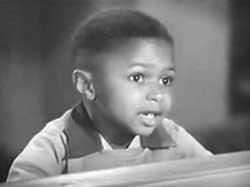 Sugar Chile had his film debut in No Leave, No Love (1946), as the littlest boogie pianist & singer the world has ever seen being a genius. He's six years old!
Sugar Chile had his film debut in No Leave, No Love (1946), as the littlest boogie pianist & singer the world has ever seen being a genius. He's six years old!
He starts banging out a great boogie piece on the piano, & sings Louis Jordan's "Caldonia." He really looks like a baby Jordan, cute as a button & more talent in his pinky than most of us have in our entire families.
This remarkable kid had an extravagant success in the 1940s, but by the time he was twelve, his career was fading. Possibly too many of his hits were the ones with little-child lyrics, & no matter how great he performed them, you can't be a teenager singing nursery rhymes. For whatever reason he just never shifted from topnotch child novelty act to adult jazzman, though he certainly was good enough.
In any case, he never regained the success he had as a child prodigy playing with Count Basie, or Lionel Hampton, at the White House, setting sell-out attendance records at Chicago's Regal Theater that would never be broken, playing the London Palladium.
When all that evaporated he'd eventually retire from entertainment but was eventually rediscovered still alive & well in his sixties living in Detroit, & was yanked out of retirement for jazz festival apeparances in the US & England.
copyright © by Paghat the Ratgirl
|
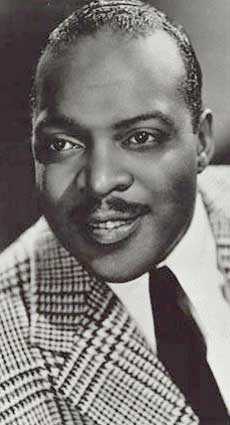




 It goes into a slow swing number thereafter, the combo staying sweet & low behind her:
It goes into a slow swing number thereafter, the combo staying sweet & low behind her:
 These guys do pretty much the same "round" of solos but with Basie's piano having the largest share of the show in Count 'Em (1950) again flowing from sax solo to clarinet solo then a highlight for the slap base & back to the Count on piano. There's no clarinet solo this time. This is the closest Basie comes to straight-out boogie-woogie b
These guys do pretty much the same "round" of solos but with Basie's piano having the largest share of the show in Count 'Em (1950) again flowing from sax solo to clarinet solo then a highlight for the slap base & back to the Count on piano. There's no clarinet solo this time. This is the closest Basie comes to straight-out boogie-woogie b

 "Them that's got shall have; them that's not shall lose/ So the Bible says, & it still is news/ Mama may have. Papa may have/ But God bless the child that's got his own. That's got his own...."
"Them that's got shall have; them that's not shall lose/ So the Bible says, & it still is news/ Mama may have. Papa may have/ But God bless the child that's got his own. That's got his own...." Extraordinary as Billie is, it's surprising to note that this film's immediate attention-getter is Frank 'Sugar Chile' Robinson, a child prodigy of jump-jazz.
Extraordinary as Billie is, it's surprising to note that this film's immediate attention-getter is Frank 'Sugar Chile' Robinson, a child prodigy of jump-jazz.